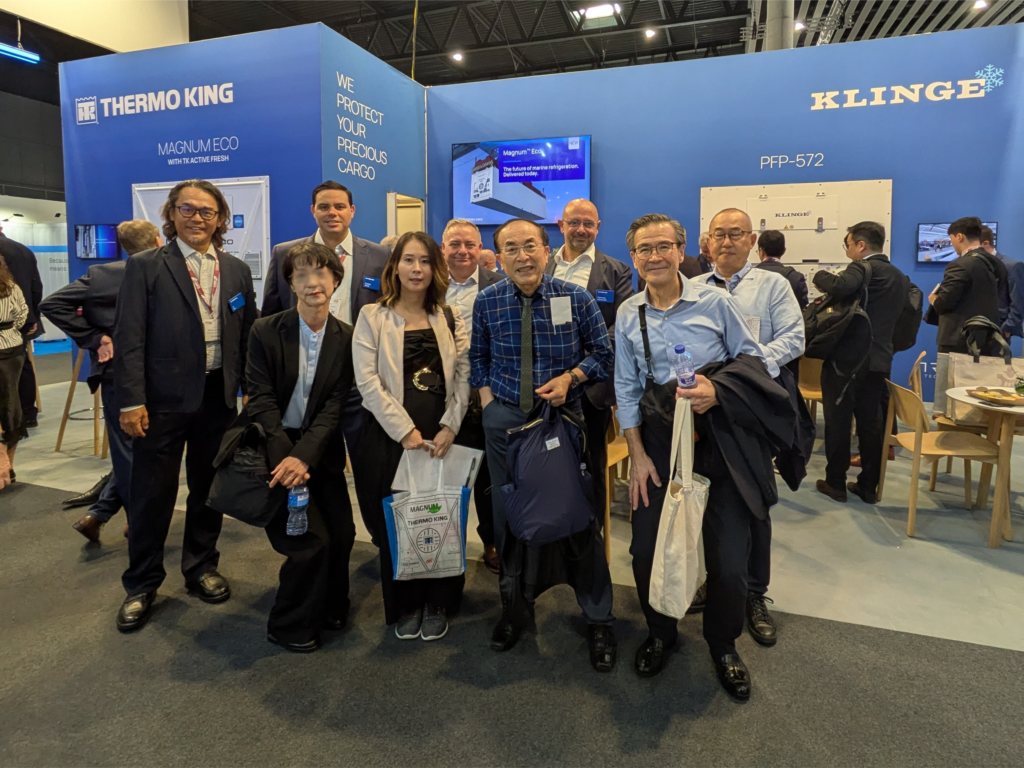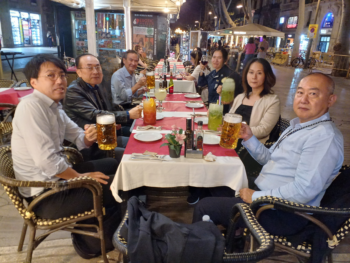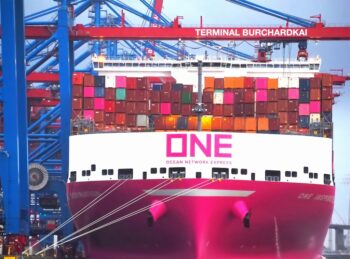Headlines
- 1 Intermodal Europe with an Eight-Member Delegation — A Journey of Surprise and Growth in Barcelona
- 2 “Takaichi Diplomacy” Gains Global Recognition — Signs of Japan’s Renewal
- 3 ONE Demonstrates the Future Vision of Container Shipping Amid Challenging Market Conditions
- 4 Container Freight Rates Expected to Decline as Supply–Demand Balance Deteriorates
- 5 Container Leasing Industry in Its Second Expansion Phase — Led by Global Investment Funds
- 6 Newly Built Containers Information in November 2025 — National Day Holiday Impact Clearly Visible
- 7 Japanese Players’ Breakthrough in MLB — A New Global Standard Born in Japan
Intermodal Europe with an Eight-Member Delegation — A Journey of Surprise and Growth in Barcelona

In late October, from the 21st to the 23rd, we attended Intermodal Europe 2025 held in Barcelona, Spain. Our delegation of eight members, including myself, was quite noticeable at the venue. Typically, companies send just one or two representatives— approx. four at most—so our large group drew a lot of attention. We intentionally bring many young team members every year so they can gain valuable exposure to the global container industry, and many participants expressed surprise at our delegation size. I asked Director Tokuyama—formerly worked for NYK Line, who visited Barcelona several times while stationed in London—to act as our tour guide. Thanks to his support, we successfully completed our itinerary without any issues throughout our stay. For the rest of us, it was our very first time in Barcelona. We took metro to everywhere, and I imagine that managing transfers by confirming stations on metro, and making reservations for events and dinners at restaurants for a group of eight was not small task.
We flew by Air France, departing Haneda at 11:45 a.m. During the connection in Paris, we had only about 90 minutes to transfer between terminals, but everything went smoothly and we arrived in Barcelona at 10:40 p.m. local time. From the airport, we took an Aerobus to the nearest stop from the hotel, then walked another seven to eight minutes to reach it. By the time we checked in and entered our rooms, it was already past midnight. I took a shower and went to bed around 2:00 a.m. but woke up every hour and a half. The next morning, when I went down to the restaurant at 7:30 a.m., the team had already finished breakfast and were heading back to their rooms. Despite the long flight, their faces were full of energy and smiles, and I was impressed by how lively everyone looked.
 At the Intermodal venue, we engaged in numerous meetings with industry contacts. I was pleased to witness the professionalism of our younger team members and to see firsthand how much they have grown—far beyond my expectations. Throughout the trip, Mr. Tokuyama, who served as our coordinator, continued his usual routine of jogging for about an hour every morning. His iron-man discipline was astonishing.
At the Intermodal venue, we engaged in numerous meetings with industry contacts. I was pleased to witness the professionalism of our younger team members and to see firsthand how much they have grown—far beyond my expectations. Throughout the trip, Mr. Tokuyama, who served as our coordinator, continued his usual routine of jogging for about an hour every morning. His iron-man discipline was astonishing.
The sky over Barcelona was a striking deep blue that seemed to stretch far away. People there were simple and relaxed in demeanor, many of them tall, and especially the women appeared with less makeup or fashion. Despite their modest style, they were very kind. While I was standing on the metro, a young woman gently tapped my hand to let me know that a seat had opened across from me.
Barcelona’s metro system has a long history—it was introduced in 1924, and today the network has more than 160 stations. The train cars themselves are modern and similar to those in Japan, but the escalators in the stations are old, sturdy, and move with a loud creaking sound. The complexity of the transfer stations and the long distances between platforms were stumped. As Barcelona is close to France, the streets have a distinct French atmosphere, with old architecture and people casually sitting at outdoor teras tables in front of cafés—even when it was cold and windy—chatting and enjoying themselves. We were told that hotel rates during this period had tripled compared with normal. The hotel we stayed at had rooms similar in size to Japanese business hotels—quite compact. I found myself missing a Japanese style bath and a washlet-equipped toilet.
“Takaichi Diplomacy” Gains Global Recognition — Signs of Japan’s Renewal
On the other hand, on Tuesday, October 21, due to biz trip, I could not witness the historic moment—the inauguration of Japan’s first female Prime Minister. The Ishiba Cabinet resigned that day, but the Liberal Democratic Party was unable to change itself. As the Komeito Party left the ruling coalition and moved to the opposition, the Liberal Democratic Party under President Sanae Takaichi became a minority government. Nevertheless, she formed a cabinet by partnering with the Japan Innovation Party.
For Dame Takaichi, who does not flatter others, to rise to the position of Prime Minister in a male dominant parliament required not only good fortune but undeniable political skill. She became the first Japanese Prime Minister—moreover, a female Prime Minister—who, from central Tokyo, flew to the U.S. nuclear-powered aircraft carrier USS George Washington anchored at the U.S. Navy base in Yokosuka by the U.S. presidential helicopter with President Trump during his visit to Japan and, after President Trump’s remarks, made an address in front of U.S. military personnel on board.
At the Asia-Pacific Economic Cooperation (APEC) summit held in Gyeongju, South Korea, from October 31 to November 2, she held a friendly meeting with Chinese Premier Xi Jinping. She also established a positive relationship with South Korean President Lee Jae-myung. Leaders of other APEC economies praised her proactive diplomatic stance, and it goes without saying that she drew significant attention and expectations as Japan’s new leader.
The world is entering a period of dramatic change, and Japan has an increasingly important role to play. In that sense, I believe, supporting Sanae Takaichi, Japan’s first female Prime Minister, beyond party lines is a mission entrusted to many politicians and citizens. This moment is also an excellent opportunity to show the world that Japan is not a country where women hold low status, on the contrary to the assumptions held by many abroad.
ONE Demonstrates the Future Vision of Container Shipping Amid Challenging Market Conditions
 Ocean Network Express (ONE), the integrated container liner company of the three Japanese shipping companies, announced its financial results for the second quarter of FY2025 (April–September) on November 4. Net profit for the quarter fell 86% year-on-year, to USD 285 million (approximately JPY 44 billion). For the first half (April–September 2025), net profit decreased 87% year-on-year, totaling USD 371 million. Although the company forecasts a net loss of USD 61 million for the second half (October 2025–March 2026), it still expects to end the full fiscal year (April 2025–March 2026) in the black, with a projected net profit of USD 310 million. Given the current market conditions, this performance demonstrates strong resilience.
Ocean Network Express (ONE), the integrated container liner company of the three Japanese shipping companies, announced its financial results for the second quarter of FY2025 (April–September) on November 4. Net profit for the quarter fell 86% year-on-year, to USD 285 million (approximately JPY 44 billion). For the first half (April–September 2025), net profit decreased 87% year-on-year, totaling USD 371 million. Although the company forecasts a net loss of USD 61 million for the second half (October 2025–March 2026), it still expects to end the full fiscal year (April 2025–March 2026) in the black, with a projected net profit of USD 310 million. Given the current market conditions, this performance demonstrates strong resilience.
Despite multiple challenges such as uncertainty surrounding U.S. tariff policies, oversupply arising from the delivery of new vessels, and persistent geopolitical risks, the fundamental growth of global supply chain demand cannot be overlooked. In addition, as nations implement economic stimulus policies and global cargo volumes increase, major liner operators must demonstrate greater flexibility in vessel deployment. In this respect, ONE remains a specialized container liner. As of the end of September, its fleet consists of 271 vessels, with a total capacity of 2,090,228 TEU, and 51 additional vessels on order. ONE is one of the few global container shipping lines capable of responding to a broad range of customer needs through its extensive global network.
Container Freight Rates Expected to Decline as Supply–Demand Balance Deteriorates
Container Freight Index (Reference: Drewry WCI)
As of October 30
Trade Lane / Index USD / FEU W/W Change Y/Y Change
Composite Index 1,822 +4% -43%
Shanghai → Rotterdam 1,795 +3% -47%
Shanghai → Los Angeles 2,438 +6% -50%
Shanghai → New York 3,568 +4% -32%
Drewry expects spot rates to rise slightly this week due to the General Rate Increase (GRI) applied on November 1. However, it forecasts that the supply–demand balance will worsen over the next several quarters, leading to a decline in spot rates.
Container Leasing Industry in Its Second Expansion Phase — Led by Global Investment Funds
 According to a report by the Japan Maritime Daily on October 27, U.S. private equity giant KKR is entering the marine container leasing business. The new company will be called Galaxy Container Solutions, and KKR is said to provide USD 500 million (approximately JPY 77 billion) in funding. Galaxy’s CEO, Jeffrey Gannon, and COO, Adrian Danner, are the co-founders of Global Container International (GCI). The two founded GCI in Boston in 2018 and grew it to a fleet of approximately 500,000 TEU in just seven years. In March of this year, they sold the company to Triton for USD 1 billion, and now—under the same titles—they are launching a new leasing platform backed by KKR.
According to a report by the Japan Maritime Daily on October 27, U.S. private equity giant KKR is entering the marine container leasing business. The new company will be called Galaxy Container Solutions, and KKR is said to provide USD 500 million (approximately JPY 77 billion) in funding. Galaxy’s CEO, Jeffrey Gannon, and COO, Adrian Danner, are the co-founders of Global Container International (GCI). The two founded GCI in Boston in 2018 and grew it to a fleet of approximately 500,000 TEU in just seven years. In March of this year, they sold the company to Triton for USD 1 billion, and now—under the same titles—they are launching a new leasing platform backed by KKR.
In essence, their strategy is to create a leasing company, scale it to around 500,000 TEU within five to seven years, and then sell it for profit. This pattern is not new. In the 1980s, there were roughly 30 container leasing companies, and many founders sought to build scale and sell to major leasing companies. As a result, the industry went through significant consolidation through M&A. Textainer, for example, expanded by acquiring other leasing companies.
There were also entrepreneurs who followed a similar strategy and gained significant wealth. One well-known figure, Ewan Karan, founded Capital Lease in the 1980s, sold it in 1993, reestablished the company in 1996, expanded the fleet to roughly 500,000 TEU, and later sold it to a fund under DVB Bank (a German investment bank), generating a substantial personal fortune.
General Electric (GE) also entered the container leasing industry aggressively in the late 1970s through GE Capital, leveraging its strong financial capability. In the late 1990s, GE formed a joint venture with the U.K.’s Sea Containers called GE SeaCo, further strengthening its position in the leasing market. However, during the global financial crisis, GE Capital suffered significant losses, and in August 2011, GE sold GE SeaCo for USD 1.0487 billion to the HNA Group (the parent company of Hainan Airlines), withdrawing from the container leasing business. Interestingly, some executives from GE SeaCo re-entered the industry, founding Gateway Leasing in 2012. However, in early 2020, Gateway sold its entire fleet of approximately 300,000 TEU to Textainer.
In September 2023, Triton — the largest container leasing company in the industry with a fleet of 7.2 million TEU — was acquired by the investment fund Brookfield Infrastructure Partners LP for USD 13.3 billion. In early 2024, the second-largest leasing company, Textainer — with a fleet of approximately 4 million TEU — was acquired by Stonepeak Infrastructure Partners for USD 7.4 billion. From the 1970s through the 2000s, M&A activity mainly occurred among container leasing companies themselves. However, since the 2010s, acquisitions by global infrastructure and private equity funds have become increasingly active. The industry is now entering what could be considered a second expansion phase for container leasing companies. This trend clearly shows that the container leasing sector is now recognized as an attractive growth industry.
There is no doubt that the container industry is poised for further significant expansion — it is not an exaggeration to call it a 100-year industry. Moreover, it is becoming evident that the larger a container leasing company’s fleet, the higher its earning potential due to economies of scale. With this backdrop, it will be extremely interesting to see how the major leasing companies continue to evolve and expand their business in the years ahead.
Newly Built Containers Information in November 2025 — National Day Holiday Impact Clearly Visible
Total new container production in October was 396,656 TEU (Dry: 356,519 TEU; Reefer: 40,137 TEU). Compared with September, production decreased by 188,185 TEU (Dry: –185,564 TEU; Reefer: –2,621 TEU), representing a decline of 32% overall (Dry: –34%; Reefer: –6%). The total factory inventory of new containers at the end of October was 1,667,591 TEU (Dry: 1,606,610 TEU; Reefer: 60,981 TEU). Compared with September, the inventory decreased by 35,565 TEU (Dry: –41,541 TEU; Reefer: +5,976 TEU). In percentage terms, this represents a 2% decrease overall (Dry: –2.5%; Reefer: +11%). Factory shipments in October totaled 432,221 TEU (Dry: 398,060 TEU; Reefer: 34,161 TEU). Compared with the previous month, shipments decreased by 187,241 TEU (Dry: –29,937 TEU; Reefer: –13,298 TEU), representing a decline of 30% overall (Dry: –9%; Reefer: –28%). The significant drop is largely attributed to the one-week National Day holiday in China and the reactionary decrease following the surge in advance export shipments prior to the holiday.
Japanese Players’ Breakthrough in MLB — A New Global Standard Born in Japan
 As a side note, in the Major League Baseball in the United States, at the last game of World Series held in last week, the Los Angeles Dodgers, who had been given a 0% chance of winning, defeated the Toronto Blue Jays in a dramatic 4–3 series victory, capturing their ninth World Series title and their second consecutive championship. Yoshinobu Yamamoto earned the World Series MVP award, and Rōki Sasaki, who once appeared physically fragile, had an outstanding performance as a relief pitcher. Shohei Ohtani, the two-way superstar, is once again a leading candidate for the season MVP award. If Ohtani wins the MVP title in 2025, it would be his fourth—following 2021, 2023, and 2024. Expectations are high. Who could have imagined that so many Japanese players would excel in Major League Baseball? I hope young people will recognize that the world is full of opportunities, and that Japanese talent can shine on the global stage.
As a side note, in the Major League Baseball in the United States, at the last game of World Series held in last week, the Los Angeles Dodgers, who had been given a 0% chance of winning, defeated the Toronto Blue Jays in a dramatic 4–3 series victory, capturing their ninth World Series title and their second consecutive championship. Yoshinobu Yamamoto earned the World Series MVP award, and Rōki Sasaki, who once appeared physically fragile, had an outstanding performance as a relief pitcher. Shohei Ohtani, the two-way superstar, is once again a leading candidate for the season MVP award. If Ohtani wins the MVP title in 2025, it would be his fourth—following 2021, 2023, and 2024. Expectations are high. Who could have imagined that so many Japanese players would excel in Major League Baseball? I hope young people will recognize that the world is full of opportunities, and that Japanese talent can shine on the global stage.